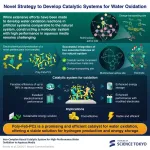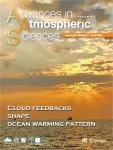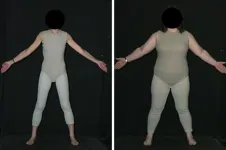(Press-News.org)
A team of Japanese researchers has discovered that Japan’s concrete structures—including buildings and infrastructure—absorb and store about 14% of the carbon dioxide (CO2) emissions generated during cement production.
This research provides vital knowledge to offset CO2 emissions from cement production, a significant contributor to global carbon emissions at approximately 8%. The study was published in the Journal of Cleaner Production.
With the growing urgency of climate change, scientists are focusing not only on reducing CO2 emissions but also on effective methods of capturing and storing atmospheric CO2 to mitigate global warming.
Concrete naturally absorbs CO2 throughout its lifetime through a process called carbonation, also known as CO2 uptake. While this process can contribute to the corrosion of reinforcing steel bars in concrete structures, it also enables concrete structures to function as carbon sinks.
Professor Ippei Maruyama of the University of Tokyo, Professor Hiroki Tanikawa of Nagoya University, and their colleagues conducted a comprehensive material stock-flow analysis of Japan's concrete from 1870 (when Japan began producing cement) to 2070. Material stock-flow analysis is an accounting method that tracks how materials enter a system (flows), accumulate within it over time (stocks), and eventually exit through disposal, recycling, or other means, allowing us to understand the complete lifecycle of resources in our economy and environment. Their analysis aimed to estimate the CO₂ uptake of concrete structures on a national scale.
The researchers used statistical data to estimate annual domestic cement production, the lifespan of various concrete structures, and their disposal methods. They quantified the total amount of CO₂ captured and stored based on the surface area of concrete structures throughout Japan.
To accurately calculate the total surface area, the researchers incorporated data on the surface-to-volume ratio of different types of concrete structures that reflect Japanese building design standards. As an earthquake-prone country, Japan has specific earthquake-resistant standards that needed to be factored into these calculations.
The study also accounted for local environmental conditions, finishing materials, and what happens to concrete after demolition. "The main objective of our analysis is to improve CO₂ uptake quantification by considering time-series changes and local-specific factors," Professor Maruyama explained.
The results revealed that the cumulative CO₂ uptake from 1870 to 2020 was estimated at 137.1 million tons, representing 7.5% of the cumulative CO₂ emissions from calcination during cement production. In 2020 alone, annual CO₂ uptake reached 2.6 million tons, accounting for 13.9% of CO₂ emissions from cement calcination that year.
Projections suggest that annual CO₂ uptake will increase slightly during the 2020s before dropping to 2.3-2.4 million tons by 2070. "These results could easily be reversed, depending on waste management methods and other conditions," the researchers noted.
Professor Tanikawa concluded: "Studies on the detailed assessment of the total CO₂ absorbed by concrete structures on the national scale are of great importance. Concrete buildings and infrastructure keep on absorbing CO₂ as long as they are exposed to the air. Concrete structures act as carbon sinks, even though they absorb less CO₂ than forests. With this in mind, we should take good care of buildings and infrastructure around us so that they have a long service life."
END
ITHACA, N.Y. – Experts see peer recognition as important to student success in physics, and a new study gives college-level physics instructors insight into how students perceive the message from their classmates that “you’re good at physics.”
Even when women receive similar amounts of recognition from peers as men for excelling in physics classes, they perceive significantly less peer recognition, the researchers found. “Men are internalizing their recognition differently than women,” said Natasha Holmes, professor of physics at Cornell University.
Holmes ...
New Haven, Conn. — Research has shown that young people who face adversity such as traumatic or stressful events during brain development are 40% more likely to develop anxiety disorders by adulthood. But most people who endure these experiences during childhood and adolescence prove to be resilient to these mental health effects.
A new Yale study finds that when this adversity occurs during brain development may affect how susceptible people are to anxiety and other psychiatric problems as adults.
According to the study, published March 5 in the journal Communications Psychology, ...
A newly developed pentanuclear iron complex (Fe5-PCz(ClO₄)₃) can offer an efficient, stable, and cost-effective solution for water oxidation. By electrochemically polymerizing the complex, researchers from Institute of Science Tokyo obtained a polymer-based catalyst, poly-Fe5-PCz, and achieved water oxidation with up to 99% Faradaic efficiency and exceptional stability, even under rigorous conditions. This breakthrough offers a scalable alternative to rare metal catalysts, advancing hydrogen production and energy storage for renewable energy.
Water oxidation plays a vital role in renewable energy technologies, ...
New research has uncovered why different climate models offer varying projections of sea surface temperature (SST) changes in the tropical Pacific, a region critical for global climate patterns. The study, published in Advances in Atmospheric Sciences on March 5, identifies cloud–radiation feedback as the dominant source behind these differences.
Reliable projections of the tropical Pacific SST warming (TPSW) pattern are crucial for understanding how global climate will change in a warming world. While the latest climate models from the Coupled Model Intercomparison Project ...
Embargoed until 8am GMT on Wednesday 5 March 2025
-With pictures-
Our perceptions of body image are shaped by what we see from as early as seven years old, according to new research by Durham University (UK).
These body ideals continue to be influenced by visual exposure to different body weights into adulthood, the research also found.
The results show that people’s perceptions of body weight are flexible and adult-like from seven years of age onwards and have implications for our understanding of body size and the perceptions, and possible misperceptions, of weight in health ...
Past research has suggested that inflammation may contribute to the development and progression of dementia and that non-steroidal anti-inflammatory (NSAID) medications may help protect against dementia due to their anti-inflammatory effects. A new large prospective study published in the Journal of the American Geriatrics Society provides additional evidence, showing that long-term NSAID use is linked to a decreased risk of developing dementia.
In the population-based study of 11,745 adults with an average follow-up of 14.5 years, 9,520 participants had used NSAIDs at any given time, and 2,091 participants developed dementia. Long-term NSAID use was associated with a 12% ...
A review in Clinical & Experimental Allergy concludes that exposing young children to small amounts of foods that they’re allergic to is safer than avoiding the foods altogether, which could be very dangerous if accidental exposure occurs.
The review notes that exposing preschool-aged children to small amounts of food allergens—called oral immunotherapy—can lessen the severity of a reaction following an accidental exposure. Also, delaying exposure until a later age misses the window ...
Because of their high metabolic rates, sea otters are especially vulnerable to disturbances that can increase their energy needs. New research in The Journal of Wildlife Management reveals how human activities affect the behavior and energy expenditure of southern sea otters.
By studying southern sea otters over 5 years at 3 sites along the coast of California, investigators found evidence that on average, the likelihood of a group of sea otters being disturbed (which affects their ability to rest) is less than 10% when stimuli such as small craft are more than 29 meters away, although this threshold varies by location, group size, ...
Online threats, hatred and harassment have led people who feel discriminated against to create digital spaces where they can feel safe. According to a new thesis from the University of Gothenburg, these spaces are characterised by clear rules and constant maintenance and monitoring.
Much of social life today takes place online. Unfortunately, the worst aspects of interpersonal relationships also appear in the digital world. A study of 51 countries revealed that 38% of women had personally experienced online harassment. Bullying and harassment have led people to create their own digital safe spaces, which is the topic ...
What inspired you to become a researcher?
My interest in research began with an early love for nature, particularly the ocean and its wildlife. Drawn to conservation, I am fascinated by how technology can help study and protect marine mammals.
Can you tell us about the research you’re currently working on?
This research focuses on using accessible 3D scanning technologies, like LiDAR-equipped mobile devices and UAV photogrammetry, to document and analyze stranded marine mammals. LiDAR (Light Detection and Ranging) is a remote sensing technology that uses laser pulses to determine the ...





